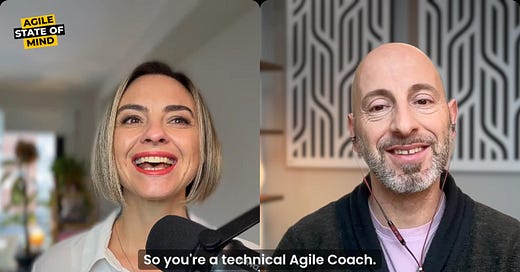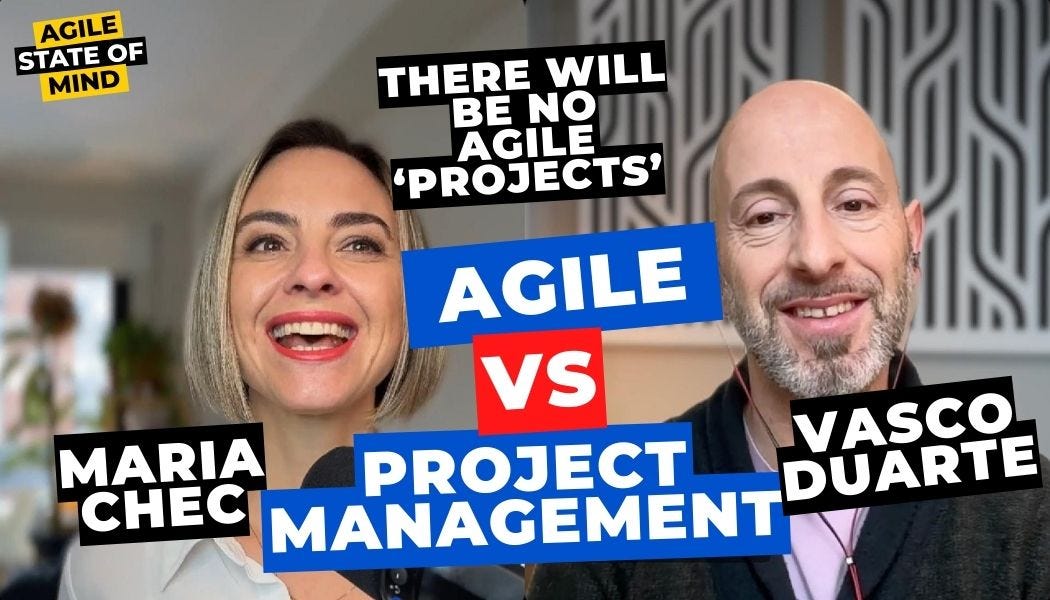The Agile community has been buzzing with discussions about the recent merger of the Agile Alliance and the Project Management Institute (PMI).
In this Agile State of Mind podcast episode, I engage in a thought-provoking conversation with Vasco Duarte to dissect what this means for Agile practitioners, how language shapes the perception of Agile, and why leadership is more critical than ever in driving Agile forward.
Vasco Duarte - A Host, A Summit Organizer And A Thought Leader
But first, let me present my guest—Vasco Duarte. He is the voice behind the Scrum Master Toolbox podcast, the most popular Agile podcast with over 10 million downloads! He has also organized countless Agile summits, including the upcoming Global Agile Summit 2025 in Tallinn, Estonia, this May. The event already has two confirmed keynote speakers: Jurgen Appelo and Gojko Adzic.
In fact, it was at one of Vasco’s online Agile summits that I took my first steps as a public speaker. I gave a talk in Spanish, though my Spanish friends later told me they could barely understand what I was saying. Things have improved quite a bit since then!
---- ⏱ Chapters ⏱ ----
00:00 Introduction to Agile and Project Management
04:25 Vasco's Journey in Agile Summits
07:09 Agile Conferences
09:47 The Merger of Agile Alliance and PMI
12:25 The Language of Agile vs Project Management
20:06 The Impact of Fear in the Workplace
26:40 How outdated language reinforces command-and-control
28:38 The Agile vs. Project Management approach to risk
29:59 The Need for New Leadership in Agile
39:09 Quality of Life in Agile Work Environments
Recently, Vasco interviewed me about the Agile Divide—a blog post and video based on Miro’s survey findings highlighting the stark contrast between how leaders and practitioners perceive Agile. Behind the scenes of that conversation, we started discussing the Agile Alliance and PMI merger. We quickly realized it was worth diving into for a full podcast episode.
The Evolution of Agile: Not Dead, Just Changing
One of the major points discussed in the conversation was the question, "Is Agile dead?" Vasco Duarte firmly believes that Agile is very much alive and evolving.
The continued interest from organizations like PMI is a testament to Agile’s strength and influence in software development and beyond.
However, the concern arises when institutions like PMI attempt to merge traditional project management with Agile. Historically, project management has been associated with fixed scope, rigid structures, and heavy documentation, whereas Agile thrives on flexibility, iteration, and collaboration. The risk is that Agile may become diluted, with its core principles being compromised for the sake of broader adoption.

Language Matters: The Struggle for Agile Terminology
A central theme in the discussion was the power of language. Vasco pointed out that terminology plays a crucial role in how Agile is understood and implemented. The PMI merger could lead to a situation where Agile terms are incorporated into traditional project management without truly embracing the Agile mindset.
For example, terms like "sprints" and "iterations" might be adopted while still enforcing waterfall-style planning, which contradicts the Agile principle of responding to change.
Continuous and incremental are two keywords within the Agile movement. There is no continuity or incrementality in project management.
Vasco Duarte
I highlighted that even in heavily project-managed environments, Agile ideas are being cherry-picked when convenient, rather than fully integrated. Hence, whenever the requirements change, it’s called “responding to change."
Fear-Based Leadership - The Panopticon
A particularly striking analogy from Vasco was the concept of the "panopticon"—a prison design where inmates never know when they are being watched. He drew parallels to corporate environments where employees are constantly under pressure to provide project updates and justify their work. This creates a culture of fear, where workers are hesitant to take risks or innovate because they are always being monitored.
True Agile environments, on the other hand, foster psychological safety. Teams should feel empowered to experiment, fail fast, and learn quickly. Fear-based leadership stifles creativity and prevents teams from fully embracing Agile principles.
The Fundamental Divide of Risk Management
We delved into the fundamental differences between project management and Agile. One of the key distinctions lies in risk management. In traditional project management, risks are often addressed at the start of a project, documented in risk registries, and periodically reviewed. In Agile, risk is managed through continuous feedback loops, incremental deliveries, and customer validation.
There is no team in the world who is doing Agile, who wants to have a risk registry! No, they want to do quick checks like paper prototypes, customer interviews, that's what they want to do.
Vasco Duarte
Vasco emphasized that software development is not a "project" with a defined end state. It is an ongoing, evolving effort that requires adaptability. Trying to fit Agile into a project management framework is like forcing a square peg into a round hole.
Agility Requires Discipline, Not Chaos
One common misconception about Agile is that it is chaotic and unstructured. Vasco firmly debunked this myth, arguing that true Agile requires extreme discipline. Successful Agile teams follow rigorous processes, maintain high standards of communication, and continuously refine their workflows to improve efficiency.
To be Agile, you need to be extremely disciplined. In fact, the only way to be successful with Agile is to have extreme discipline in how we execute our work.
Vasco Duarte
For instance, Agile teams conduct frequent retrospectives, track key performance indicators, and rigorously prioritize work based on value delivery. These practices require commitment and structure, not a lack of organization.
A Call for New Agile Leadership
As the discussion came to a close, Vasco made a passionate call to the Agile community to take ownership of the future. He warned that if Agile practitioners do not step up to defend and advance Agile principles, we could see a regression to outdated project management practices.
He cited examples of massive software project failures of the Nordic countries, that resulted in billions of wasted dollars due to poor planning and rigid project management methodologies.
The only way to prevent history from repeating itself is for Agile leaders to take a stand, create their own language for software delivery, and reinforce the principles that make Agile effective.
Conclusion: The Transformation Starts With Us
This episode of Agile State of Mind served as both a warning and a call to action. The PMI-Agile Alliance merger presents both risks and opportunities. While it signifies Agile’s mainstream acceptance, it also raises concerns about dilution and misinterpretation of Agile principles.
As Agile practitioners, we must remain vigilant, challenge outdated paradigms, and ensure that Agile continues to drive meaningful change. The transformation starts with us. We are responsible for the future of Agile!
What do you think about the PMI and Agile Alliance merger? Let us know in the comments!
Join my Kanban Training!
Join My Kanban Course: Enhance Your Workflow with Kanban Practices
As a Professional Kanban Trainer, I’d like to invite you to join the Applying Professional Kanban course. After passing the exam, you’ll get the Professional Kanban I (PK I) certification.

















Share this post